Por defecto, WordPress muestra las entradas de su blog en la página de inicio. Sin embargo, si usted está haciendo un sitio web de negocios o simplemente desea personalizar su página de inicio, entonces es posible que desee una página separada para su sección de blog.
Esta configuración no solo le ayuda a mantener su página de inicio limpia y centrada, sino que también proporciona un espacio dedicado para que los lectores exploren el contenido de su blog.
Para mejorar la experiencia del usuario y mantener un enfoque claro en nuestras ofertas, hemos añadido páginas de blog separadas en muchos de los sitios web de nuestras empresas asociadas, incluyendo WPForms, OptinMonster, y All in One SEO. Esto permite a los visitantes acceder fácilmente al contenido del blog, al tiempo que se da prioridad al objetivo principal de promocionar nuestros plugins.
En este artículo, le mostraremos dos formas de crear una página separada para entradas de blog en WordPress.
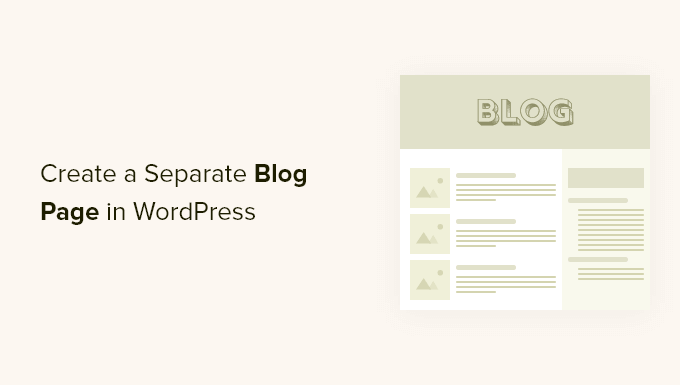
¿Por qué mostrar las entradas del blog en una página aparte?
La página de inicio es la página principal de su sitio web WordPress y la primera página que ven sus visitantes. Por defecto, WordPress muestra tus entradas más recientes en tu página de inicio, y eso tiene sentido si tienes un blog.
Pero no siempre es ideal para sitios web de pequeñas empresas. Probablemente querrá una página de inicio más atractiva que informe a los usuarios acerca de su negocio, productos y servicios, les permita saber cómo ponerse en contacto con usted y aumente la conversión de sus ofertas.
Ahora bien, si también quiere tener un blog en su sitio web, entonces tendrá que proporcionar otra página donde los visitantes puedan ir a leer sus entradas.
Dicho esto, le mostraremos cómo crear fácilmente una página separada para entradas de blog en WordPress.
En este tutorial, hemos discutido dos métodos, y puede utilizar los enlaces de abajo para saltar al método de su elección. Tenga en cuenta que el segundo método es el más sencillo y ofrece la mayor personalización:
Tutorial en vídeo
Si prefiere instrucciones escritas, siga leyendo.
Método 1: Crear páginas separadas para entradas de blog en WordPress
Puede crear una página separada para las entradas del blog utilizando los ajustes por defecto de WordPress.
Sin embargo, este método requiere un poco más de trabajo que el método 2 y no ofrece tantas opciones de personalización.
Crear una página de inicio y una página de blog separadas
En primer lugar, debe crear dos páginas de WordPress separadas para utilizarlas como página de inicio / página de blog.
No tiene que añadir ningún contenido a esas páginas y puede ponerles el nombre que quiera. Por ejemplo, algunos sitios web de empresas utilizan “Noticias” para su página de blog.
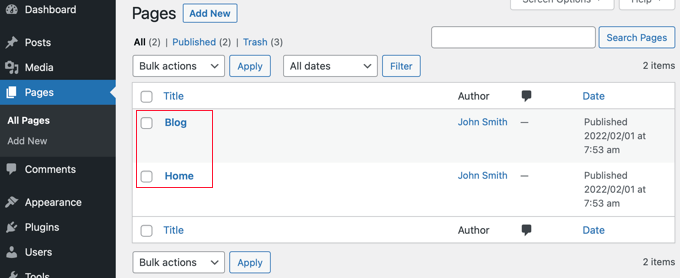
Una vez que haya creado esas páginas, visite la página Ajustes ” Lectura en el área de administrador de WordPress.
En la sección “Su página de inicio”, haga clic en el botón “Una página estática”.
A continuación, puede seleccionar las páginas de inicio y blog que creó anteriormente. A continuación, desplácese hacia abajo y haga clic en el botón “Guardar cambios”.

Ahora, cuando navegue a la pantalla Páginas ” Todas las páginas desde el escritorio de WordPress, verá que la página de inicio está etiquetada como ‘Página de inicio’ y la página de blog está etiquetada como ‘Página de entradas’.
Haz clic en el enlace “Ver” situado bajo la página del blog para obtener una vista previa.
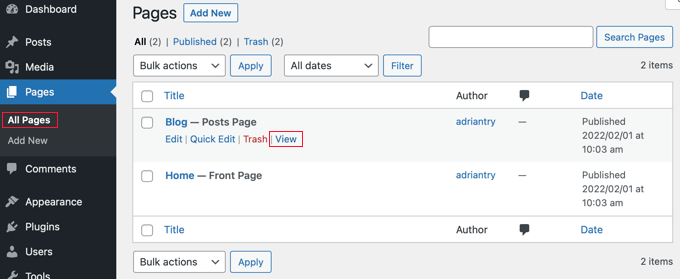
La apariencia de estas páginas depende de su tema de WordPress, y puede que desee establecer estos ajustes.
Por ejemplo, si tu tema tiene un menú de navegación, entonces notarás que WordPress ha añadido automáticamente las nuevas páginas de blog y de inicio. Si no es así, consulte nuestra guía para principiantes sobre cómo añadir un menú de navegación en WordPress.
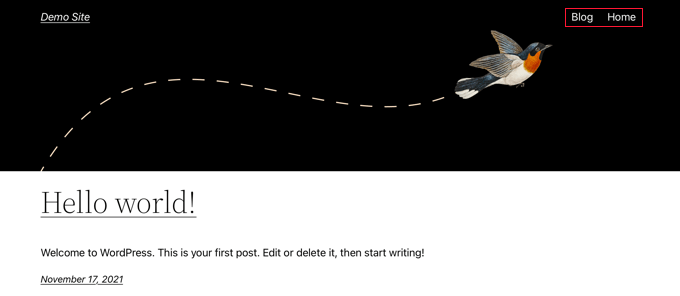
Personalizar la página de inicio / página de inicio
Hasta ahora, su nueva página de inicio está en blanco. Ahora es el momento de añadir información acerca de su empresa, productos y servicios, y de indicar a sus visitantes cómo pueden ponerse en contacto con usted.
Puedes aprender cómo hacerlo en nuestra guía sobre cómo crear una página de inicio personalizada en WordPress. En el Método 1, te mostramos cómo utilizar el editor de bloques para añadir imágenes de portada, columnas, tablas, texto y medios, galerías y mucho más.
También encontrará muchas ideas creativas de personalización en nuestra guía sobre cómo editar una página de inicio de WordPress de forma fácil y eficaz.
Personalice la página de su blog
Si está satisfecho con el aspecto de la página de su blog, el trabajo ha terminado.
Sin embargo, si está utilizando un tema basado en bloques, también puede personalizar la página de su blog visitando la pantalla Apariencia ” Editor desde el escritorio de WordPress.
Una vez allí, seleccione la opción “Páginas” en la columna izquierda del editor del sitio completo.
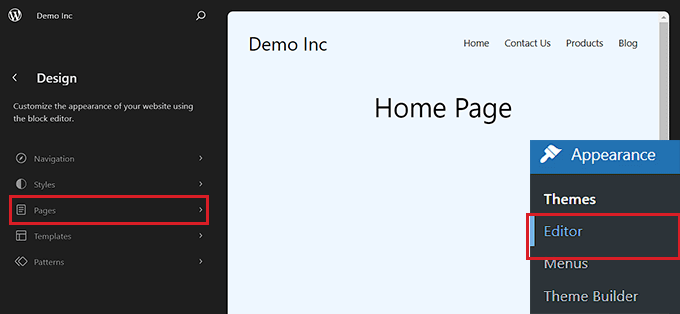
Se abrirá una lista de todas las páginas de su sitio web en la columna de la izquierda.
Desde aquí, seleccione la opción de página “Blog” y, a continuación, haga clic en la vista previa de la página de la derecha para empezar a personalizar la página de su blog.
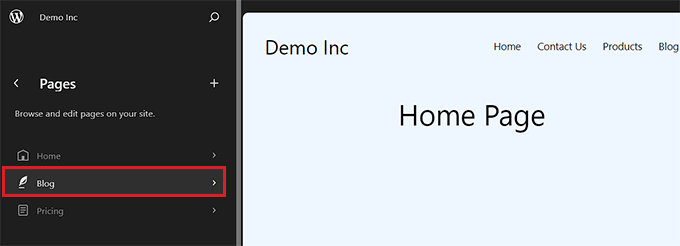
Ahora puede hacer clic en el botón “+” de la esquina superior izquierda de la pantalla y añadir los bloques que desee a la página.
Además, puede cambiar el fondo, el texto o el color de los enlaces de la página de su blog haciendo clic en el icono “Estilos” situado en la esquina superior derecha de la pantalla.
Se abrirá un panel de bloques a la derecha desde el que podrá hacer clic en la pestaña “Tipografía” para cambiar el color del texto, en la pestaña “Colores” para cambiar el color de fondo y en la pestaña “Disposición” para configurar las dimensiones de la página de su blog.
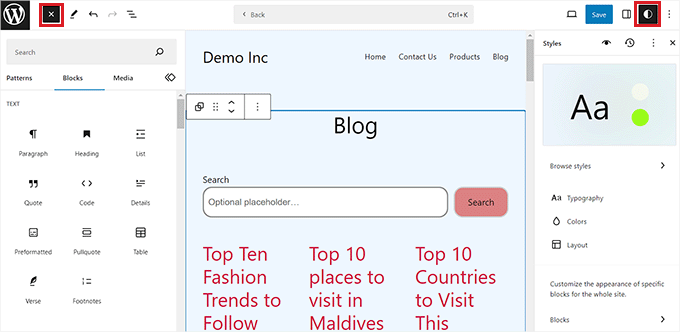
Cuando hayas terminado, no olvides hacer clic en el botón “Guardar” de la parte superior para guardar tus ajustes.
Ahora, puedes visitar la página de tu blog WordPress para ver cómo queda.
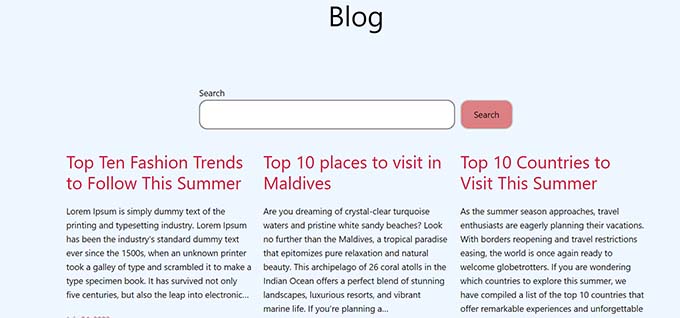
Sin embargo, si utiliza un tema clásico, deberá utilizar el método 2 para personalizar la página de entradas de su blog.
Método 2: Creación de una página personalizada para entradas de blog con un maquetador de arrastrar y soltar (Recomendado)
Un plugin maquetador de temas permite crear fácilmente un tema de WordPress personalizado sin necesidad de código. Esto incluye la posibilidad de crear y personalizar una página independiente para las entradas del blog.
Instalación del maquetador de temas SeedProd
Primero, necesitas instalar y activar el plugin SeedProd. Para más detalles, consulte nuestra guía paso a paso sobre cómo instalar un plugin de WordPress.
SeedProd es el mejor editor de arrastrar y soltar página de WordPress para empresas, bloggers y propietarios de sitios web. También cuenta con un diseñador de temas que te permite personalizar fácilmente la página de tu blog y mucho más.
Puede leer nuestra reseña / valoración completa de SeedProd para más detalles.
Tras la activación, visite la página SeedProd ” Ajustes para introducir su clave de licencia. Puede encontrar esta información en su cuenta del sitio web de SeedProd.

Después de eso, es hora de crear un tema de WordPress personalizado. Esto es mucho más sencillo de lo que parece.
Creación de un tema de WordPress personalizado
En primer lugar, debe visitar la página del maquetador de temas de SeedProd. Aquí, usted utilizará uno de los temas listos de SeedProd como punto de partida. Esto reemplazará su tema de WordPress existente con un nuevo diseño personalizado.
Puede hacerlo al hacer clic en el botón “Temas”.
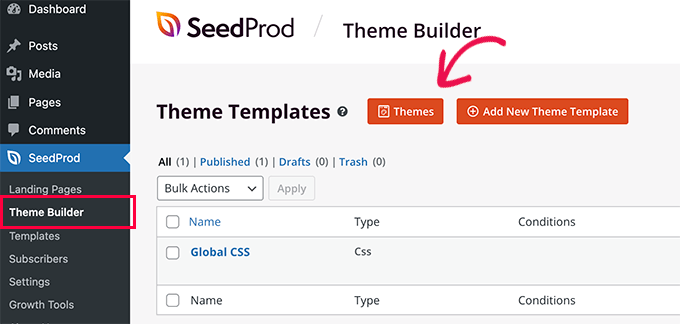
Ahora se le mostrará una lista de temas diseñados profesionalmente para diferentes tipos de sitios web.
Por ejemplo, hay plantillas denominadas “Empresa moderna”, “Agencia de marketing” y “Tema de agente hipotecario”.
Eche un vistazo a las opciones y seleccione la que mejor se adapte a sus necesidades al hacer clic en el icono de la marca de verificación.
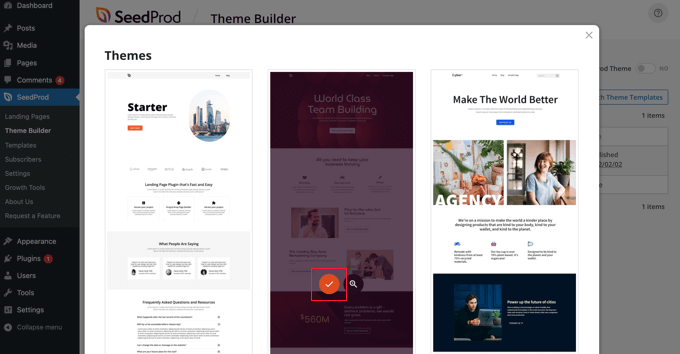
Una vez que haya elegido un tema, SeedProd generará todas las plantillas de temas, incluyendo una para el índice de su blog y otra para su página de inicio.
No se trata sólo de páginas vacías, sino que vienen establecidas con atractivas disposiciones y marcadores de posición de contenido fáciles de personalizar.
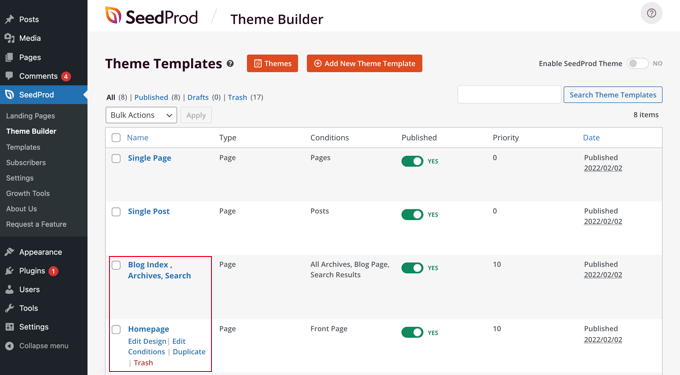
En este tutorial, le mostraremos cómo personalizar las plantillas de la página de inicio y del índice del blog.
También puedes personalizar las otras plantillas. Para saber cómo hacerlo, consulta nuestra guía para principiantes sobre cómo crear fácilmente un tema de WordPress personalizado.
Personalizar la página de inicio / página de inicio
Una vez que haya generado sus plantillas de temas, puede editarlas utilizando el maquetador de temas de SeedProd. Comenzaremos con la plantilla de página de inicio.
Para empezar, sólo tiene que enlazar el enlace “Editar diseño” situado bajo la página de inicio.

Esto iniciará el archivo de plantilla en el maquetador de temas de SeedProd.
Este sencillo maquetador de arrastrar y soltar mostrará una vista previa en vivo de su página a la derecha y una barra de herramientas de bloques a la izquierda.
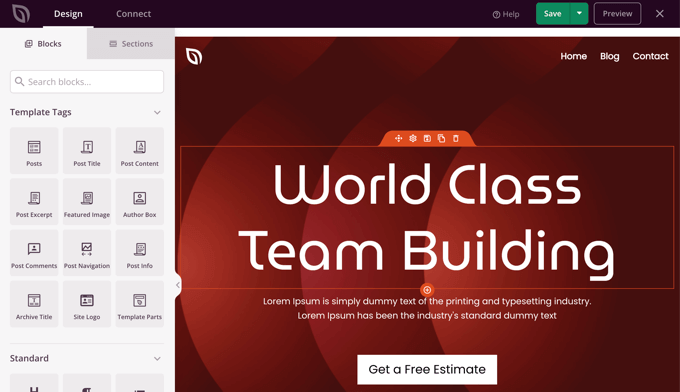
Puede personalizar cualquier bloque al hacer clic en él, arrastrar bloques arriba y abajo con el ratón y añadir nuevos bloques a la página.
Hemos escrito una guía completa sobre cómo crear una página de inicio personalizada en WordPress. Simplemente desplácese hacia abajo hasta el Método 2 para aprender a personalizar su página de inicio utilizando SeedProd.
Personalice la página de su blog
El maquetador de temas de SeedProd también ofrece muchas formas de personalizar la página de índice de tu blog.
Al hacer clic en el enlace “Editar diseño” situado debajo de la página, podrá empezar con los primeros pasos.

Verás el mismo panel de vista previa a la derecha y la barra de herramientas a la izquierda. Puede personalizar la página de blog del mismo modo que lo hizo con la página de inicio.
Por ejemplo, al hacer clic en el titular, podrás ver todos sus ajustes. Puedes editar el texto, cambiar la alineación y el tamaño de la fuente, y mucho más.
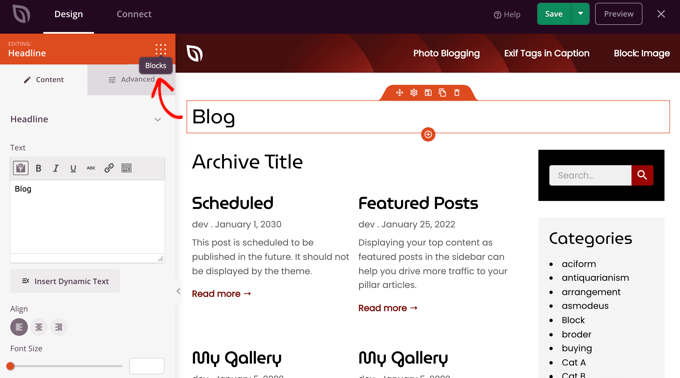
Cuando hayas terminado, tendrás que hacer clic en el icono “Bloques” para volver a la barra de herramientas.
El maquetador de temas SeedProd ofrece bloques adicionales de partes de plantillas, como el bloque Entradas, que muestra una lista de las entradas de tu blog.
El bloque Entradas ya se ha añadido a la plantilla de índice del blog para ti, y en esta plantilla, el bloque muestra tus entradas en dos columnas. Podemos cambiar esto a una sola columna.
Simplemente haz clic en el bloque Entradas y cambia el ajuste “Columnas” a 1.
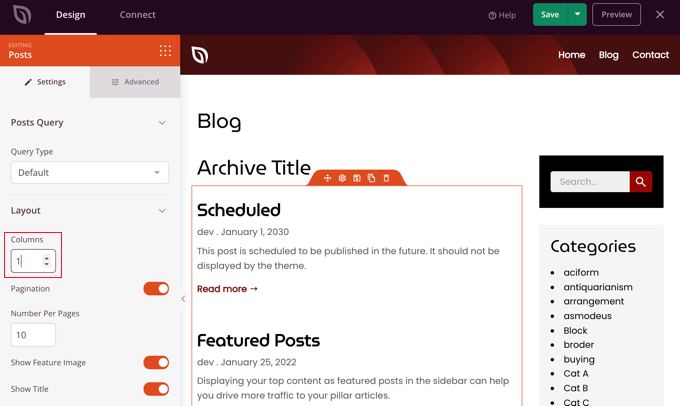
La estructura / disposición / diseño / plantilla cambiará inmediatamente a una sola columna.
A medida que te desplazas por los ajustes del bloque Entradas, encontrarás conmutadores que te permiten elegir si mostrar o no la imagen y el título de la característica de la entrada. También puedes elegir qué etiqueta de cabecera utilizar para el título de la entrada.
También hay opciones para mostrar distintos metadatos de las entradas. Puede conmutar la fecha de modificación, el autor, la fecha y hora de publicación y el recuento de comentarios.
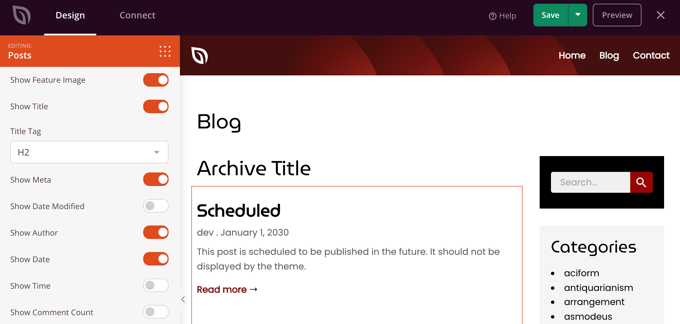
A continuación le ofrecemos otras formas de personalizar el índice de su blog:
- Puede filtrar el índice por tipo de entradas, categoría, etiqueta o autor.
- Se puede cambiar el orden / orden de las entradas.
- Puede elegir cuántas entradas se muestran en una página.
- Puede conmutar el extracto de la entrada y personalizar su longitud.
Cuando haya terminado de personalizar la página de su blog, asegúrese de hacer clic en el botón “Guardar” situado en la parte superior de la pantalla. A continuación, puedes volver a la lista de plantillas al hacer clic en el icono ‘X’.
Activar el tema SeedProd
Una vez que haya terminado de personalizar las plantillas de temas, deberá publicar el nuevo tema personalizado.
Sólo tiene que establecer el conmutador “Activar tema SeedProd” en la posición “SÍ”.
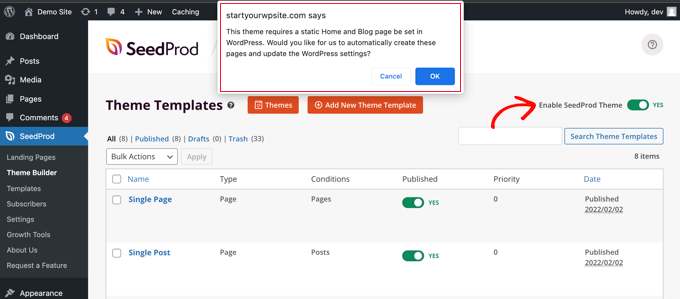
Inmediatamente verá un aviso de que es necesario cambiar los ajustes de la página de inicio / blog de WordPress. Al hacer clic en el botón “Aceptar”, se modificarán estos ajustes.
Ahora puede visitar su sitio web para ver su nueva página de inicio / página de blog. Este es el aspecto de la página de índice del blog en nuestro sitio de demostración.
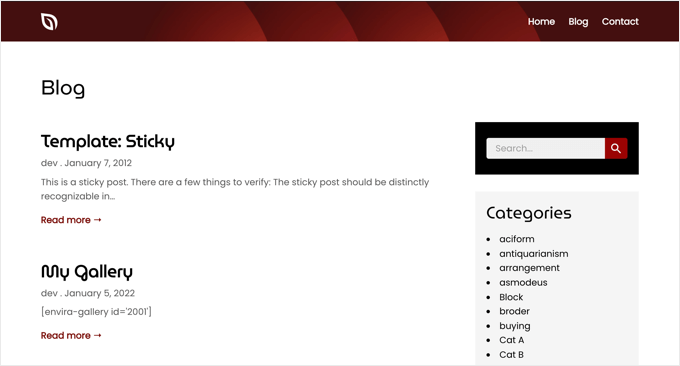
Bonus: Muestra tus entradas recientes en WordPress
Una vez que haya creado una página de blog independiente, puede seguir mostrando algunas entradas recientes en su página de inicio para animar a los usuarios a explorar más su sitio.
Para ello, abra su página de inicio en el editor de bloques de WordPress. Una vez allí, haga clic en el botón “Añadir bloque” situado en la esquina superior izquierda de la pantalla para abrir el menú de bloques.
A partir de aquí, sólo tienes que añadir el bloque “Últimas entradas” a la página. Una vez hecho esto, puedes personalizar la lista de entradas recientes para mostrar extractos de entradas, nombres de autores y fechas a tu gusto.
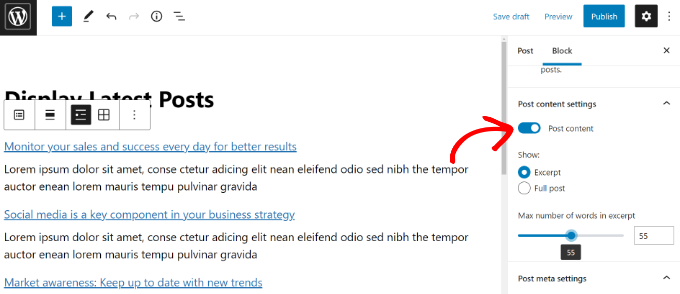
Por último, haz clic en el botón “Publicar” de la parte superior para guardar tus ajustes. Ahora, algunas de tus entradas recientes seguirán apareciendo en la página de inicio para que los usuarios pasen más tiempo en tu sitio web.
Para más información, puede consultar nuestro tutorial sobre cómo mostrar entradas recientes en WordPress.
Esperamos que este tutorial te haya ayudado a aprender cómo crear una página separada para entradas de blog en WordPress. Puede que también quieras aprender cómo añadir un estado de entrada personalizado para entradas de blog en WordPress o comprobar nuestra lista de los mejores plugins de entradas relacionadas para WordPress.
If you liked this article, then please subscribe to our YouTube Channel for WordPress video tutorials. You can also find us on Twitter and Facebook.





Maria
HELP PLEASE: I have created a BLOG PAGE using PAGES. I have added it to the navigational menu and set it as blog on the page attributes.
I have written a post but this does not appear on the blog page. Any suggestions on what I am doing wrong. I have the latest WordPress update using a MacBook pro.
Thanks
Stephanie
I have successfully created a Home page and Blog page showing the latest posts i.e. 10, is there any way to show more or at least get to the Archive of posts; even by increasing the number this does not seem to change. Thanks.
andrea
Hi i followed this makes lots of sense. Prob is under my MENU creation page and this page you direct us too. I do not see the BLOG page or Home page i created!! Its so frustrating and my web designer wont help me. Any reason why wordpress wont show all the pages or posts i make?
pls help
geetha
Hi
I have a wordpress page.the menu are Home, Blog, About me and Contact.
I am trying to add another page like the “Blog” – obviously under another title, where i can have different topics/ headings. I am currently using a free wordpress.
Bascially i want more blog posts so i can classify my writing under one wordpress site.
Please help.
Kind regards,
Geetha.
Lauren
Very helpful, exactly what I was looking for!
MFH
Thanks, is there any way to add additional design features to the blog page? I’m using a divi child theme and set up a blog page but all design elements are wiped out when I designate the page as the blog page, only the basic primary header and posts show.
Nick tann
I see how this adds a blog page but do I add multiple blog posts to the same page? Is that how it works? Is there a way I can emulate a blog type site on one of my pages like a running diary?
WPBeginner Support
Hi Nick,
No, you would create your blog posts just like you would normally do and they will automatically appear on this page. Yes, it will allow you to keep your blog posts on a separate page like a running diary.
Admin
Bob
This was very helpful. Thank you. bob
kalpana
Thanks for the content…was very useful to me
mahbub
Thank u so much
Melissa
Thank you!
Antony Ramirez Ferrigno
That was very well explained for a total beginner like me!
Cheers
Asumpta
This was incredibly helpful to me especially as a beginner. Thank you
Chris
I followed your video and adjusted my permalink to /blog/%postname%/ and everything works fine when I click on each posts, but I have 10 pages of posts and when I click on the next page on the very bottom of my blog to view my next set of posts I get 404 error page not found.
It returns my permalink as my domain.com/blog/page/2/ which is a 404 error how do I fix this?
How do I fix this so I can see the next pages of posts?
Bo
If you have published posts before adding your blog page, you will need to do a 301 redirect on all the older posts to redirect them to the new ‘blog’ path.
Adnan sami
Thank You Very Much For this kind of help.. it works fine with my blogs and online businesses
WPBeginner Support
You are welcome
Admin
Emma Pacecca
Hi!
I understand how to make the separate page for blog posts, but I am wondering if I can make multiple pages for blog posts in different categories – so I can add travel related blogs to the travel page, lifestyle to the lifestyle page, etc. ?
Any help would be much appreciated!
Thank you!
WPBeginner Support
Please take a look at how to add topics in WordPress navigation menu
Admin
geetha
Hi
Do let me know if you have sorted this out please. Need the same help.
JANITA
You’ve just saved me HOURS. Thank you!
UT
Hi,
I have created a blog page on my website but it does not seem to be updating with the posts I’m putting on there. In addition I need the blog link to go to a separate webpage and not be part of the main website page. Is that possible?
Thanks
UT
Hi,
I created the blog page but when I’ve put in posts it’s not showing in the blog page. Additionally while I have the blog page link on my main front page menu, when I click on the page, I want it to go separately and not be part of the main page theme. Is that possible?
My website is
Thx
Lauri Rottmayer
Thank you so much! So easy but it was totally eluding me.
Valerie
@wpbeginner You have saved the day! I have had an issue with this for months and thought I was smart enough to figure it out but was struggling! This helped fix the issue and although it was still easy, I would have never known how to navigate without this article. Thank you!
WPBeginner Support
Hey Valerie, glad you found it useful You may also want to subscribe to our YouTube Channel for WordPress video tutorials.
You may also want to subscribe to our YouTube Channel for WordPress video tutorials.
Admin
Kasey
Hello I have created a “Home” page as well as a “Blog Posts” page but I want my posts to show up on y home page as well as my blog posts page. How would I go about doing that?
Mar
Hello
I really can’t seem to find where to go. I can add a new page but then it looks completely different then on your screen? are there other ways to do it?
Karen
Tthank you so much for this video!!! I knew it was a simple thing but couldn’t for the life of me find the right setting. Your a lifesaver!!
WPBeginner Support
You are welcome Don’t forget to subscribe to our YouTube Channel for WordPress video tutorials.
Don’t forget to subscribe to our YouTube Channel for WordPress video tutorials.
Admin
Princess Valera
Hi,
I want to ask something, My WordPress doesn’t have Reading Settings it only have Writing Settings. What can i do? Any help? I hope you’ll answer this.
Thanks!
Alissa
I had this problem too, you have to access the Settings through the Word Press Admin (WP Admin) and there is a Reading option there.
Corey
How do I find the WP Admin? I’m having the same problem.
WPBeginner Support
Hey Corey,
Please see our guide on how to find your WordPress login URL.
Eric A. Flores
Great! This was precisely what I needed to know. Much appreciated to such an extent!
WPBeginner Support
You are welcome, make sure you follow us on Twitter to get more WordPress tips and tricks.
Admin
Brandon
Hi, so, I’ve already made a home page, as well as many other pages. But my question is, I want to post on more than ONE page.. Example, I blog about school AND life and I want themto post on separate pages that I’ve made. How can I do this? Thank you!
WPBeginner Support
WordPress comes with a built-in feature called Categories. It allows you to create posts and file them into different categories. Your homepage may show all your posts. But you will also have category archive pages, where users will be able to see all posts filed under that particular topic. Please see our guide on how to add topics to navigation menus in WordPress
Admin
Anjali Kulkarni
how to what
WPBeginner Support
Hey Anjali,
Edited the comment, thanks for pointing this out
Shashank Naithani
Hello Syed,
I have already done this thing and would like to know after changing my bog post page to news the URL is oming like this http://localhost/wp-yfu/news/
however when I click on the post the URL change to http://localhost/wp-yfu/hello-world/
How can I change the url to http://localhost/wp-yfu/news/hello-world/
WPBeginner Support
You can go to Settings » Permalinks and click on custom structure to add /news/ as a prefix to your blog posts. Like this:
/news/%postname%/
Admin
Toby Akuj
Thanks for this excellent tutorial. The static home page requires a URL distinct from the site URL. How do I make the static home page (www.example.com/home/) actually be the home page (www.example.com)? Does it have to be through a URL redirect, or is there a cleaner way?
WPBeginner Support
Go to Settings > Reading page and then select the page you want to set as your homepage by clicking on the dropdown next to ‘Front Page’ option. Don’t forget to save your changes.
Admin
Chinedu Godwin
How do i create a whole new page,where i get to post stuff and engage people to comments on it,it would be different from my normal Blog homepage… I intend on calling the page “community”…
Rei
@wpbeginner, is it possible to command one page to have one category of blog posts?
Ex. I want my page “day in the life of Rei” to have its own blog posts
WPBeginner Support
All categories in WordPress have their own pages. You can file all posts under “day in the life of Rei” category and then add that category into your navigation menu. See our guide on how to add topics in WordPress navigation menu
Admin
Ron Levis
I’m trying to add a Blog page to my existing site with several pages. I already have a “Home” page. Do I need to create a 2nd “Home” page, i.e. ‘Bog Home’ or something like that? When I tried to publish the new Page for the Blog the link simply took page viewers to my main web site’s home page. Thank you!
WPBeginner Support
By default, WordPress has posts (entries in a blog) and pages. See our guide on difference between posts vs pages.
You can create different static pages. For example, you can create a static page to be used as your home page. You can also create a separate page for blog posts. This blog post page does not have any content of its own. It is simply used to display posts published on your blog.
Admin
Samantha
Hi! thanks for the tutorial, can you also make on Blogger?
Daisy
Hi!
This was really helpful! Thanks!
Just have a quick question…
On my home page I want to show say eg. 6 of my latest posts and then have a parent page with all my posts showing up on it as well, is this possible??
Thanks,
Daisy
Alaa
Hi there
I just created a wordpress blog, and everything is going fine so far except my post that appears on home page don’t link to other pages. for example when i post a blog about beauty i want it to link to the beauty page as well home page but this is not working with me. please help! how do i link each post to related page as well as showing in front page?
thank you
Alaa
WPBeginner Support
You need to file your post into categories or tags Then you can add those topics into your navigation bar. See our guide on how to add topics in WordPress navigation menu.
Admin
Sara
Hi,
I wanted to know if it’s possible to create more than 5 static pages on blog site? I haven’t been able to do so. Is that the maximum number of pages you can put up?
WPBeginner Support
No you can create as many pages as you want.
Admin
Amin
Hi there, I want to show less words in post pages. all the content show in post page and i want to show less.
Please help me !
Christian
This video and explanation is so clear and helpful. But it still doesn’t work with me
I don’t have a template for blog, but I follow every other step carefully.
The result is, when I am on my static frontpage and press the blog button in the upper right menu, the new window that opens up, is all blank, except it says test in the top left corner.
Has anyone tried this, and know how to fix it?
Thanks in advance.
Page is a template - You Need to Make a Post
What appears to be with this is the Page creation is only a template and will not display any text or content you happen to write in the page WYSIWYG editor.
If you post a test “post”, and publish it, that post will appear as a regular excerpt post item on that page.
Publish 2-3 test posts and you will see the posts listed on the blog page. Without any posts at all, you will get a near blank page with something like “not found” and with a search box below it.
Did that help?
Momo
This is not working. I still dont have home page to be my blog and to be seen in the page menu
Raju Ferdiansyah
hello, nice tips.
i would to ask you how to make my url is like this
mydomain.com/tutorial-web/post.html and not mydomain.com/category/tutorial-web/post.html
and if my visitor go to mydomain.com/tutorial-web/ the will find all post with ‘Tutorial Web’ category at that page
sorry for my bad english
Thanks for your tutorial, your website is amazing for beginner like me
WPBeginner Support
You may want to take a look at our guide about using SEO friendly url structure in WordPress.
Admin
Katy Pollard
Searched everywhere for this and you finally answered it for me! Thanks!
Nick
Perfect! This was exactly what I wanted to know. Thanks so much!
WPBeginner Support
Glad you found it helpful.
Admin
Maarten
Same thing here! Exactly my problem! Very helpful indeed.
Roderick Stirling
Nice! Thanks.
Raymond
Hi! I would like to know how to make an “overview” of all the blogs you have posted? Please help me out
Pradeep Sahoo
the blog page is going to the main page means home page.
why i don’t know, any suggestion??
Vikram Chouhan
its work really nice, thanks
Muhammad Ali Pasha
The video was really helpful, i am stuck in one more problem ahead of it, its that all the posts do appear in blog page of mine but their permalink is not showing the page name BLOG in it, it’s like
website.com/postname and not
website.com/blog/postname… can you please help me in this regard ?
WPBeginner Support
you can edit permalinks by visiting Settings » Permalinks page. There you can check the custom structure checkbox and use /blog/%postname%/ as your permalink structure. Please note that it will change all your WordPress URLs, this could be bad for SEO.
Admin
tirza
Oh my Gosh thank you!!!!!! Eventually I’ll be able to post the volg about me being able to finally make A PAGE, YES, YES, YES
Patch Welling
I’m a novice to WP and your tutorial is the most helpful I have found so far in rebuilding my website. Thank you.
WPBeginner Support
Glad you found it helpful.
Admin
jayps
Hi, Im new with word press. I did this exactly and was finished customizing my home page. When I was to customize my Post page, I cannot see the “Template” and its corresponding drop down in the “Page attributes.”
Is this because of the theme? Is there any way that I can create a template for my Post page so I can customize the page where my blogs will be posted?
Thanks
Dana
@wpbeginner – Awesome tutorial, very helpful. Now I would like to seek your wise council regarding an issue: I made a seperate news/blog page and it’s all working fine. On my full-width homepage I display a bit of all my pages (services, about us, contact etc). But HOW do I feed the posts from the news section back tot the homepage (I have 4 blocks with only the title and h1 of the news article)?
Thanks!